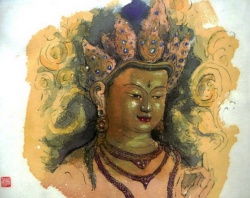Difference between revisions of "Charya tantra yana"
(Created page with " <poem> Charya tantra, Upa tantra, or Ubhaya tantra is a yana (literally "vehicle") of Esoteric Buddhism-though there is debate about whether ...") |
|||
| Line 1: | Line 1: | ||
| − | + | {{DisplayImages|1081|1426|514}} | |
<poem> | <poem> | ||
[[Charya tantra]], [[Upa tantra]], or [[Ubhaya]] [[tantra]] is a [[yana]] (literally "[[vehicle]]") of [[Esoteric]] Buddhism-though there is [[debate]] about whether it is considered to be [[buddhism]], and as such is both a class of [[tantric]] {{Wiki|literature}} and of praxis. The [[yana]] of [[Charya]] or ‘conduct’ [[tantra]] is given this [[name]] because it demonstrates a balanced emphasis on the outer [[ritual]] [[actions]] and ablutions of [[body]] and [[speech]] and the inner cultivation of {{Wiki|intentionality}} and [[mindfulness]]. Hence, outer and inner conduct. The [[Charya]] tanta is enumerated as one of the three [[Outer Tantras]] in both the four-tantric-yanas {{Wiki|classification}} scheme of the [[Sarma]], or '[[New Translation]] Schools' and the nine-yana {{Wiki|classification}} of the [[Nyingma]], '{{Wiki|Ancient}} Translation School'. | [[Charya tantra]], [[Upa tantra]], or [[Ubhaya]] [[tantra]] is a [[yana]] (literally "[[vehicle]]") of [[Esoteric]] Buddhism-though there is [[debate]] about whether it is considered to be [[buddhism]], and as such is both a class of [[tantric]] {{Wiki|literature}} and of praxis. The [[yana]] of [[Charya]] or ‘conduct’ [[tantra]] is given this [[name]] because it demonstrates a balanced emphasis on the outer [[ritual]] [[actions]] and ablutions of [[body]] and [[speech]] and the inner cultivation of {{Wiki|intentionality}} and [[mindfulness]]. Hence, outer and inner conduct. The [[Charya]] tanta is enumerated as one of the three [[Outer Tantras]] in both the four-tantric-yanas {{Wiki|classification}} scheme of the [[Sarma]], or '[[New Translation]] Schools' and the nine-yana {{Wiki|classification}} of the [[Nyingma]], '{{Wiki|Ancient}} Translation School'. | ||
| − | |||
| − | |||
| − | |||
| − | |||
| − | |||
| − | |||
| − | |||
| − | |||
Upayogatantra or [[Ubhayatantra]] ([[Sanskrit]]; Wylie: [[spyod pa'i rgyud]] kyi [[theg pa]], [[Tibetan]]: {{BigTibetan|སྤྱོད་པའི་རྒྱུད་ཀྱི་ཐེག་པ}}). In the lexical compound [[Ubhaya-tantra]], '[[ubhaya]]' ([[Sanskrit]], {{Wiki|Devanagari}}: उभय) is a pronominal adjective that qualifies '[[tantra]]' (English: loom, {{Wiki|weaving}}) and holds the {{Wiki|semantic field}} of 'two' or 'dual'. | Upayogatantra or [[Ubhayatantra]] ([[Sanskrit]]; Wylie: [[spyod pa'i rgyud]] kyi [[theg pa]], [[Tibetan]]: {{BigTibetan|སྤྱོད་པའི་རྒྱུད་ཀྱི་ཐེག་པ}}). In the lexical compound [[Ubhaya-tantra]], '[[ubhaya]]' ([[Sanskrit]], {{Wiki|Devanagari}}: उभय) is a pronominal adjective that qualifies '[[tantra]]' (English: loom, {{Wiki|weaving}}) and holds the {{Wiki|semantic field}} of 'two' or 'dual'. | ||
| Line 15: | Line 7: | ||
One interpretation of '[[Ubhaya]]' as the ‘[[tantra]] of both’ is demonstrated in that its {{Wiki|literature}} and exponents hold the [[view]] of [[Yogatantra]], whilst its conduct and [[activity]] is therein, as a general rule, is aligned with that of [[Kriyatantra]] and in [[function]], [[forms]] a bridge between the two other [[Outer Tantras]]. | One interpretation of '[[Ubhaya]]' as the ‘[[tantra]] of both’ is demonstrated in that its {{Wiki|literature}} and exponents hold the [[view]] of [[Yogatantra]], whilst its conduct and [[activity]] is therein, as a general rule, is aligned with that of [[Kriyatantra]] and in [[function]], [[forms]] a bridge between the two other [[Outer Tantras]]. | ||
| − | |||
| − | |||
| − | |||
[[Tantras]] in this class | [[Tantras]] in this class | ||
| − | + | Davidson relates the {{Wiki|movement}} of the [[Mahãvairocanãbhisaṃbodhi-tantra]] by the [[Ch'an]] [[monk]] Wu-hsing (2002: p. 118): | |
| − | |||
| − | |||
| − | |||
| − | |||
| − | Davidson relates the {{Wiki|movement}} of the Mahãvairocanãbhisaṃbodhi-tantra by the [[Ch'an]] [[monk]] Wu-hsing (2002: p. 118): | ||
"The [[Ch'an]] [[monk]] Wu-hsing remarked around 680 C.E. that the popularity of the [[esoteric]] [[path]] was a new and [[exceptional]] event in [[India]], observable even while he was in residence. He reputedly brought back with him the earliest version of the Mahãvairocanãbhisaṃbodhi-tantra, although he did not translate it." | "The [[Ch'an]] [[monk]] Wu-hsing remarked around 680 C.E. that the popularity of the [[esoteric]] [[path]] was a new and [[exceptional]] event in [[India]], observable even while he was in residence. He reputedly brought back with him the earliest version of the Mahãvairocanãbhisaṃbodhi-tantra, although he did not translate it." | ||
| Line 39: | Line 23: | ||
"Conduct [[tantra]], where conduct encompasses both outer [[ritual]] [[activity]] and inner contemplation, involves training in a vast range of [[deeds]] while entering the inner [[reality]] that presents itself in [[visual]] and audible [[divine]] {{Wiki|representations}}. The notion here is that of being close to the state of a perfect [[divine being]], a state not yet fully [[realized]]. This limited [[view]] is overcome by [[visualizing]] oneself as the [[deity]], [[understanding]] that [[form]] to be the [[appearance]] aspect of [[emptiness]]." | "Conduct [[tantra]], where conduct encompasses both outer [[ritual]] [[activity]] and inner contemplation, involves training in a vast range of [[deeds]] while entering the inner [[reality]] that presents itself in [[visual]] and audible [[divine]] {{Wiki|representations}}. The notion here is that of being close to the state of a perfect [[divine being]], a state not yet fully [[realized]]. This limited [[view]] is overcome by [[visualizing]] oneself as the [[deity]], [[understanding]] that [[form]] to be the [[appearance]] aspect of [[emptiness]]." | ||
| − | [[Jinpa]] (2004) renders a section of 'A [[Garland of Views]]' ([[Tibetan]]: {{BigTibetan|མན་ངག་ལྟ་བའི་ཕྲེང་བ}}, Wylie: [[man ngag lta ba'i phreng ba]]) that focuses [[Ubhaya]] [[tantra]] through the lens of the [[Two truths doctrine]], a text attributed to [[Padmasambhava]] in the [[Mantrayana]] [[tradition]], thus: | + | [[Jinpa]] (2004) renders a section of 'A [[Garland of Views]]' ([[Tibetan]]: {{BigTibetan|[[མན་ངག་ལྟ་བའི་ཕྲེང་བ]]}}, Wylie: [[man ngag lta ba'i phreng ba]]) that focuses [[Ubhaya]] [[tantra]] through the lens of the [[Two truths doctrine]], a text attributed to [[Padmasambhava]] in the [[Mantrayana]] [[tradition]], thus: |
"The [[view]] of those who have entered the [[vehicle]] of [[Ubhaya-tantra]] is as follows. Whilst there are no origination and [[cessation]] on the [[Wikipedia:Absolute (philosophy)|ultimate]] level, on the [[Wikipedia:Convention (norm)|conventional]] level one [[visualizes]] [oneself] in the [[form]] of a [[deity]]. This is cultivated on the basis of both the practice of [[meditative]] [[absorption]] endowed with four aspects as well as the [necessary] [[ritual]] articles and [[conditions]]." | "The [[view]] of those who have entered the [[vehicle]] of [[Ubhaya-tantra]] is as follows. Whilst there are no origination and [[cessation]] on the [[Wikipedia:Absolute (philosophy)|ultimate]] level, on the [[Wikipedia:Convention (norm)|conventional]] level one [[visualizes]] [oneself] in the [[form]] of a [[deity]]. This is cultivated on the basis of both the practice of [[meditative]] [[absorption]] endowed with four aspects as well as the [necessary] [[ritual]] articles and [[conditions]]." | ||
Latest revision as of 08:46, 1 January 2014
Charya tantra, Upa tantra, or Ubhaya tantra is a yana (literally "vehicle") of Esoteric Buddhism-though there is debate about whether it is considered to be buddhism, and as such is both a class of tantric literature and of praxis. The yana of Charya or ‘conduct’ tantra is given this name because it demonstrates a balanced emphasis on the outer ritual actions and ablutions of body and speech and the inner cultivation of intentionality and mindfulness. Hence, outer and inner conduct. The Charya tanta is enumerated as one of the three Outer Tantras in both the four-tantric-yanas classification scheme of the Sarma, or 'New Translation Schools' and the nine-yana classification of the Nyingma, 'Ancient Translation School'.
Upayogatantra or Ubhayatantra (Sanskrit; Wylie: spyod pa'i rgyud kyi theg pa, Tibetan: སྤྱོད་པའི་རྒྱུད་ཀྱི་ཐེག་པ). In the lexical compound Ubhaya-tantra, 'ubhaya' (Sanskrit, Devanagari: उभय) is a pronominal adjective that qualifies 'tantra' (English: loom, weaving) and holds the semantic field of 'two' or 'dual'.
One interpretation of 'Ubhaya' as the ‘tantra of both’ is demonstrated in that its literature and exponents hold the view of Yogatantra, whilst its conduct and activity is therein, as a general rule, is aligned with that of Kriyatantra and in function, forms a bridge between the two other Outer Tantras.
Tantras in this class
Davidson relates the movement of the Mahãvairocanãbhisaṃbodhi-tantra by the Ch'an monk Wu-hsing (2002: p. 118):
"The Ch'an monk Wu-hsing remarked around 680 C.E. that the popularity of the esoteric path was a new and exceptional event in India, observable even while he was in residence. He reputedly brought back with him the earliest version of the Mahãvairocanãbhisaṃbodhi-tantra, although he did not translate it."
Exegesis
The Carya class of tantras holds the smallest number of texts of all the traditional classifications of tantric literatures. An important tantra in this class is the Mahavairocana Sutra. The presence of Buddha Vairocana is often evident in tantras of this class where he is often depicted in the centre of a mandala with four other Buddhas of his retinue placed to the four quarters, the cardinal directions. Importantly, during the Carya tantra class and literary period, there developed the salient innovation wherein the sadhaka is to cultivate identification with the deity in meditative absorption.
This class of literature was important to Kūkai (774–835) and the development of Shingon Buddhism. Kūkai traveled to China in 804 as part of the same expedition as Saichō. In the T'ang capital of Xian, Kūkai studied esoteric Buddhism and Sanskrit and received initiation from Huikuo. Kukai received a lineage of the Mahavairocana Sutra (Dainichikyo 大日経). On returning to Japan, Kūkai establish the esoteric school of Shingon (真言).
Guarisco & McLeod et al. (2005: p. 41) set Jamgon Kongtrul's (1813–1899) codification of this class in English as follows:
"Conduct tantra, where conduct encompasses both outer ritual activity and inner contemplation, involves training in a vast range of deeds while entering the inner reality that presents itself in visual and audible divine representations. The notion here is that of being close to the state of a perfect divine being, a state not yet fully realized. This limited view is overcome by visualizing oneself as the deity, understanding that form to be the appearance aspect of emptiness."
Jinpa (2004) renders a section of 'A Garland of Views' (Tibetan: མན་ངག་ལྟ་བའི་ཕྲེང་བ, Wylie: man ngag lta ba'i phreng ba) that focuses Ubhaya tantra through the lens of the Two truths doctrine, a text attributed to Padmasambhava in the Mantrayana tradition, thus:
"The view of those who have entered the vehicle of Ubhaya-tantra is as follows. Whilst there are no origination and cessation on the ultimate level, on the conventional level one visualizes [oneself] in the form of a deity. This is cultivated on the basis of both the practice of meditative absorption endowed with four aspects as well as the [necessary] ritual articles and conditions."
Praxis
In sadhana, the sadhaka visualizes themselves or ritually rarefies their mindstream into the 'commitment being' (Sanskrit: samayasattva) and visualizes the 'gnosis being' (Sanskrit: jñānasattva), who is envisioned in the relationship of a spiritual friend, to their front and facing them which subsumes a certain style of form meditations or meditations with a support: e.g.: bija, mudra, mandala and/or rupa of the deity, the 'gnosis being', the yidam.


